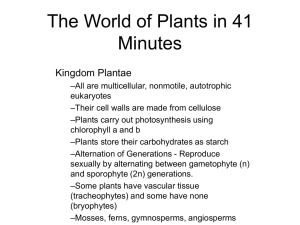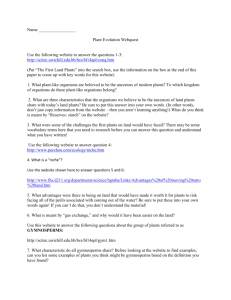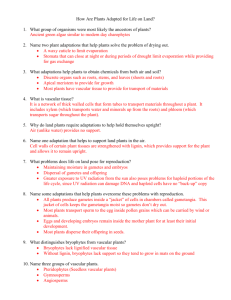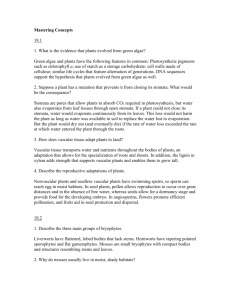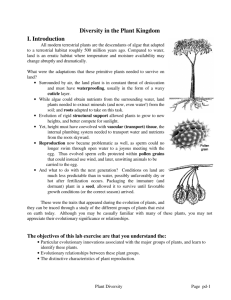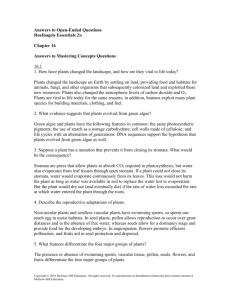Exam 3 Review
advertisement
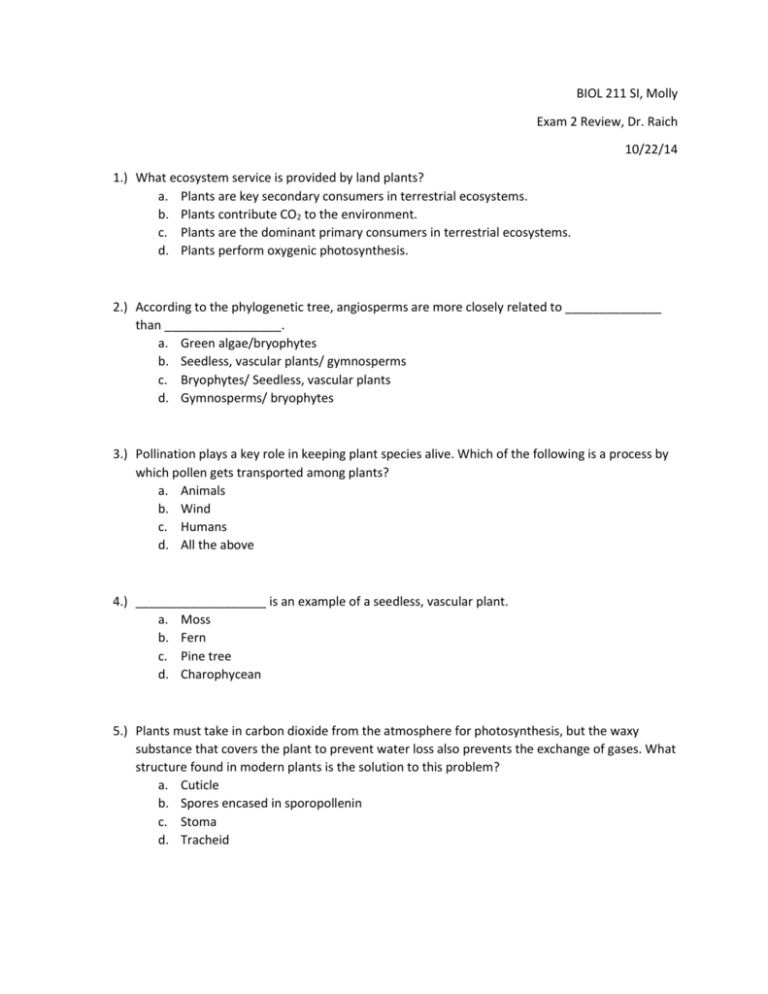
BIOL 211 SI, Molly Exam 2 Review, Dr. Raich 10/22/14 1.) What ecosystem service is provided by land plants? a. Plants are key secondary consumers in terrestrial ecosystems. b. Plants contribute CO2 to the environment. c. Plants are the dominant primary consumers in terrestrial ecosystems. d. Plants perform oxygenic photosynthesis. 2.) According to the phylogenetic tree, angiosperms are more closely related to ______________ than _________________. a. Green algae/bryophytes b. Seedless, vascular plants/ gymnosperms c. Bryophytes/ Seedless, vascular plants d. Gymnosperms/ bryophytes 3.) Pollination plays a key role in keeping plant species alive. Which of the following is a process by which pollen gets transported among plants? a. Animals b. Wind c. Humans d. All the above 4.) ___________________ is an example of a seedless, vascular plant. a. Moss b. Fern c. Pine tree d. Charophycean 5.) Plants must take in carbon dioxide from the atmosphere for photosynthesis, but the waxy substance that covers the plant to prevent water loss also prevents the exchange of gases. What structure found in modern plants is the solution to this problem? a. Cuticle b. Spores encased in sporopollenin c. Stoma d. Tracheid 6.) Studying land plant evolution allows biologists to determine what the terrain was like millions of years ago. In what ways can biologists study land plants? a. Using molecular phylogenies b. Using the fossil record c. Using morphologies d. All the above are ways to study land plants. e. None of the above are good ways to study land plants. 7.) What are contained within the pollen grains? a. Female eggs b. Fruits c. Seeds d. Male gametophytes 8.) Over 250,000 species of angiosperms have been described, with more being discovered each year. Their highly successful outcome is due in large part to: a. Seed dispersal b. Humans c. Pollination d. All the above e. None of the above 9.) Place the following adaptations in order of their evolutionary appearance in green algae and land plants: A. Waxy coatings B. Alternation of generations C. Flowers D. Seeds E. Vascular systems a. B – C- E – A – D b. B – A – E – D – C c. E – B – A – D – C d. C – D – E – A – B 10.) A gametophyte produces ____________ through ______________, and a sporophyte produces _______________ through _______________. a. Gametes/meiosis; spores/mitosis b. Spores/meiosis; gametes/mitosis c. Gametes/ mitosis; spores/meiosis d. Spores/mitosis; gametes/ meiosis 11.) What feature of the evolution of land plants is supported by the phylogenetic tree shown in the figure below? a. b. c. d. Sexual reproduction did not evolve until vascular plants diversified. Horsetails, ferns, and whisk ferns make up the most basal groups among land plants. The transition of plants from freshwater environments to land occurred only once. Nonvascular plants and seedless vascular plants evolved simultaneously from green algae. 12.) The Carboniferous Period refers to the time when: a. The Earth was covered in extensive forested swamps. b. Angiosperms had not evolved yet. c. The source of our fuel today was thriving. d. All the above. 13.) Land plants perform _______________ of the global photosynthesis. a. None b. Not very much c. Half d. All 14.) Which of the following statements about seed plants is true? a. Angiosperms produce “naked seeds.” b. Angiosperms have more species diversity that other taxa of land plants. c. Seed plants lack vascular tissue. d. Gymnosperms have more species diversity than other taxa of land plants. 15.) Which of the following is NOT a key adaptation for gymnosperms? a. Seeds b. Wood c. Flowers d. Pollination 16.) When plants evolved on land, they paved the way for animals and fungi. a. True b. False 17.) Which pair of morphological traits is used to define the three categories into which land plants are classified? a. Which habitats the plants colonize, and which photosynthetic pigments they contain. b. Whether or not they produce flowers, and whether or not their seeds are developed in enclosed structures. c. Where plants appear in the fossil record, and the closeness of their phylogenetic relationships. d. Whether or not the plants contain vascular tissue, and whether or not they produce seeds. 18.) Green plants consist of both green algae and land plants. A difference between the two is that: a. Green algae live in aquatic and land environments, but land plants only live on the land. b. Land plants are the only ones to perform oxygenic photosynthesis. c. Land plants are the dominant autotrophs in terrestrial environments. d. None of the above. 19.) In non-vascular plants, ______________ arose on the leaves to prevent water loss. a. Cuticles b. Sporangium c. Xylem and phloem d. Pollen 20.) What does the presence of a coal mine in an area indicate about that region’s geologic history? a. Marshy, swampy, or boggy habitats were once found there. b. Water in this area was well oxygenated. c. Coal seams were likely available and exploited by native humans in the region thousands of years ago. d. Shallow seas were once located there. 21.) In the life cycle of an angiosperm, the egg: a. Forms from meiosis of cells inside the seed. b. Must be fertilized by a sperm that swims to it with its flagella. c. Is one of the cells formed by mitosis in the ovule. d. Is part of a mobile female gametophyte. 22.) The living plants that are the most similar to the first plants to bear vascular tissues are: a. Green algae b. Bryophytes c. All the above d. None of the above 23.) Plants can be readily used by humans for: a. About 50% of pharmaceuticals b. Clothing supplies c. Tires for our vehicles d. All the above 24.) Which statement about the ecological services provided by plants best explains why coastal areas with cultivated fields and developed neighborhoods tend to suffer far more damage from a hurricane than do areas with natural forest and marsh habitats? a. Developed habitats tend to be more humid than natural environments and are therefore more susceptible to the input of water during a hurricane. b. Intact forests and wetlands can reduce the effects of winds during a hurricane and lessen the impact of erosion. c. Intact forests and wetlands allow accumulated water to quickly run off a landscape. d. Plants release oxygen into the environment. 25.) ________________ is the reproductive structure that allows the sperm to be transported in the absence of water. a. Fruit b. Pollen c. Anther d. Stigma 26.) What adaptation reduced the dependence of seed plants on water for fertilization? a. Sporophytes b. Seed c. Pollen grains d. Gametophytes 27.) Ferns have a specific place where the gametophytes are located. This structure is on the underside of the leaves and is called the: a. Microsporangium b. Archegonium c. Stamen d. Sorus 28.) Which of these characteristics is shared by algae and seed plants? a. Chloroplasts b. Pollen c. Roots and shoots d. Vascular tissue e. Embryo development within gametangia 29.) Identify the correct pollination syndrome. a. Brightly colored flowers are pollinated by moths, which are attracted to bright colors. b. Bee-pollinated flowers have long, tube-like structures to protect the bees. c. Flowers pollinated by hummingbirds are generally white, as hummingbirds lack color vision. d. Carrion flowers produce molecules that smell like rotting flesh to attract flies. 30.) Which of the major taxa of land plants living today has only a single member? a. Ginkgos b. Gnetophtyes c. Hornworts d. Cycads 31.) Plants adapted life on land relatively recently. a. True b. False 32.) Which of the following statements best supports the hypothesis that flowers are adaptations increasing fertilization success in terrestrial environments? a. The evolution of the flower increased the success of wind pollination. b. Heterospory – the production of two distinct types of spores by different structures – is unique to flowers. c. Flowers attract pollinators to increase pollination success. d. Flowers are adaptive because they produce endosperm, which protects the female gametophyte from predators. 33.) What do seeds contain? a. Male gametophyte and nutritive tissue b. Female gametophyte and nutritive tissue c. Embryo and nutritive tissue d. Mature sporophyte and nutritive tissue 34.) Flowers are specialized structures that enhance reproductive success. They contain two key reproductive structures: the _____________ is the __________ structure and the _____________ is the ____________ structure. a. Stamen/male; carpel/female b. Petal/ female; Stigma/ male c. Stamen/female; carpel/male d. Petal/ male; Stigma/ female 35.) Many adaptations occurred between branches on the phylogenetic tree. One adaptation was the change from gametophyte-dominance to sporophyte-dominance, which happened between: a. Green Algae and Bryophytes b. Non-vascular, seedless plants and vascular, seedless plants c. Vascular seedless plants and seed plants d. Gymnosperms and angiosperms 36.) All of the following are examples of seedless, vascular plants except: a. Horsetails b. Mosses c. Club mosses d. Ferns e. Whisk Ferns 37.) All land plants have a life cycle featuring alternation of generations. Explain the similarities or differences in roles played by the following life cycle stages (the stage that is the most dominant): pine trees, leafy ferns, beds of mosses, and a flowering rose bush. a. Rose bushes, ferns, and pine trees produce spores. The commonly visible stage of mosses releases gametes. b. All of these stages produce sperm and eggs. c. All of these stages release spores that develop into gametophytes. d. Structures on the ferns, roses, and pine trees release pollen that develop into the male gametophyte. Mosses do no produce pollen. 38.) Why is it obvious that tall corn plants seen from a car window do NOT belong to the bryophyte lineage? a. Bryophytes only grow in dry conditions. b. Unlike corn and other crop plants, bryophytes do not reproduce sexually. c. Bryophytes lack vascular tissue and grow close to the ground. d. Unlike corn, bryophytes do not carry out photosynthesis and would not appear green. 39.) Which group of seed plants is named for its unique cone-shaped reproductive structure? a. Gnetophytes b. Angiosperms c. Cycads d. Conifers 40.) Which of the following statements is an accurate description of tracheids? a. Tracheids are only used for structural support. b. Tracheids are only found in the early vascular plant lineages. c. Tracheids provide support with their primary cell wall and transport water through gaps in their secondary cell wall. d. Tracheids are used as a mean to attract pollinators. 41.) The gametophytes of plants can be differentiated as the sperm-producing and egg-producing structures. These are respectively called the a. Stamen and carpel b. Antheridiophore and archegoniophore c. Xylem and phloem d. Gametangia and Sporangia 42.) Biologists hypothesize that the first land plants had a low, sprawling growth habitat. Which of the following statements support this hypothesis? a. The wind speed was much greater at that time than it is now, restricting the height of the first land plants. b. To obtain water, the first land plants had to keep their tissues in direct contact with moist soil. c. Low, sprawling growth protected the first land plants from herbivores. d. The low, sprawling growth increased the surface area of the first land plants, providing them with additional light for photosynthesis. 43.) Gymnosperms evolved after angiosperms. a. True b. False 44.) All land plants, except angiosperms, contain this feature that protects the antheridiophore and archegoniophore as they develop. a. Gametangia b. Filaments c. Style d. Carpel 45.) Which major evolutionary trends in green plants are supported by the order in which distinct plant taxa are found in the fossil record? a. The evolution of land plants from green algae, and the gradual evolution of traits that reduce the dependence of land plants on wet environments b. A distinct break from algae lineages and continued dependence on moisture for reproduction. c. The steady development in the ability of land plants to produce increasingly sophisticated spores. d. Nonvascular and vascular plants arising independently from separate taxa of green algae. 46.) The mutual evolutionary influence of two unrelated species on each other, while acting as selective agents on one another is defined as: a. Double fertilization b. Coevolution c. Binary fission d. Endosymbiosis 47.) Within gymnosperms, there are four phyla. Out of those four phyla, which one contains plants that resemble a mix between a fern and a palm tree? a. Ginkgos b. Cycads c. Peat moss d. Lycophytes 48.) The appearance of cuticle and stomata correlated with what event in the evolution of land plants? a. The first erect growth forms b. The first woody tissues c. Growth on land d. The evolution of the first water-conducting tissues 49.) What is one reason that we study plants? a. Plants provide the environment with oxygen. b. Plants provide all organisms energy. c. Plants are foundation of branches of our educational system, such as agronomy and horticulture. d. All the above. 50.) The main purpose of fruit is to: a. Fertilize the plant b. Disperse the seeds c. Taste good d. Produce spores 51.) Many pharmaceuticals have been derived from land plants. These chemicals are used in plants mainly as _______________. a. Defense against predators and parasites b. Reproductive structures c. Structural components d. A source of energy 52.) Mitosis results in a ___________ or _____________ organism, while meiosis results in a ____________ organism. a. Haploid/diploid/haploid b. Haploid/diploid/diploid 53.) Animals in a South American rain forest have been travelling long distances with their pack. Their original location contained many mango trees, and where they’re going doesn’t contain hardly any. In ten years, small mango trees started to appear in abundance. This is most likely caused by: a. Wind having taken the seeds to the other side of the forest. b. The animals eating and carrying the fruit seeds, then excreting them on the other side of the forest. c. Humans replanting the trees on the other side of the forest. d. None of the above. 54.) Double fertilization results in two products, a seed coat and a 3n structure called: a. A baby. b. A gamete c. An endosperm d. A spore 55.) Sporophytes produce ______________ via the process of __________________. Spores give rise to __________________, which produce ________________ via the process of _____________. A. Meiosis B. Mitosis C. Gametes D. Spores E. Gametophytes a. D – C – A – E – B b. A – B – E – D – C c. E – A – C – B – D d. D – A – E – C – B 56.) Gymnosperms and Angiosperms have all the following in common except: a. Vascular tissue b. Seeds c. Ovaries d. Pollen 57.) You are walking through a grove of trees the day after a heavy rain. You see on the side of a tree a green fuzz. Because you look Biology 211, you know that the green fuzz is the ____________ of a moss. a. Sporophyte b. Tracheid c. Gametophyte d. Zygote 58.) Stamens, sepals, petals, carpels, and pine cone scales are all: a. Found on angiosperms b. Capable of photosynthesis c. Modified leaves d. Female reproductive parts 59.) In liverworts, the sporophyte is located a. On top of the gametophyte. b. In the middle of the antheridiophore. c. Under the brim of the archegoniophore. d. Independently away from the gametophyte. 60.) A ______________ is a mature ovary. a. Seed b. Fruit c. Gamete d. Spore




